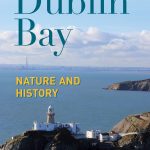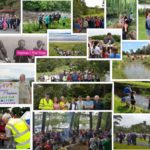On the fringe of Dublin’s hive of human activity, a…
Nature on our Doorsteps: Volume 1
Many of us of a certain generation who have an interest in nature and conservation most likely grew up searching hard for any information on the creatures and plants that lived around us at home.
Trips to the Library or to local book shops would of course have yielded information but this mostly addressed British birds, plants, trees and insects. In fact, growing up, we probably knew more about the exotically named butterflies on the chalk downs in Britain or about the lions and gazelles in the Serengeti National Park than we did about the snails, bumblebees, or ‘weeds’ in our own back gardens.

A recently published book, ‘Nature on our Doorsteps; Volume 1’ offers a little glimpse into some of these everyday features of the natural heritage in our own immediate environment, attempting to raise the profile of those things that are generally overlooked because they are seen as being ‘ordinary’.
Following the seasons throughout the year, this book highlights a range of both well-known and less recognised insects, plants and invertebrates that can literally be found in our own back gardens, if we take the time to look.

The book is a product of a partnership between South Dublin County Council’s Heritage Officer, Rosaleen Dwyer, and the Echo Newspaper Group in Tallaght, Co. Dublin. Since July 2017, The Echo has published weekly biodiversity columns as provided by the Council’s Heritage Officer. The articles are short, approximately 200 words, and are accompanied by two photographs. They follow the seasonal changes that occur in the gardens, parks, roadside verges and public open spaces in South Dublin County, anywhere that most people are likely to encounter nature.
The only skill that is required is the ability to stop, stand, and look.
For many people, ‘buzzing’ things are to be shooed away or squashed before they sting. This leaves very little time to observe what their true identities are, how they behave, or how we might be benefiting from their activities. They may turn out to be a rare or a threatened bumblebee, or even a fascinating bumblebee mimic – a ‘bumblebee in disguise’.

Who are nature’s recyclers and nature’s colonisers? What are witch’s brooms? When is a berry not a berry? Why do some trees hang onto withered leaves over winter? What exactly is stem ‘spittle’? How do plants survive the cold of winter? Why are cowslips the ‘come-back kid’? Who are nature’s air conditioners?
These are just some of the topics covered in Volume 1 of Nature on our Doorsteps. A second volume is expected later in 2020. While being everyday examples of the natural diversity that is to be found around us, the subjects at the heart of these articles are the basic building blocks of the natural world. Protecting and enhancing these ‘ordinary’ building blocks is therefore key to protecting our own future as a species. The first step is getting to know and value what is around us.
Rosaleen Dwyer, Heritage Officer, South Dublin County Council
Learn more:
Nature on our Doorsteps Volume 1 is available from the County Library, Tallaght, Dublin.








